Active 1939–45 Role Air superiority Founded 1939 | Size Air Force Wing | |
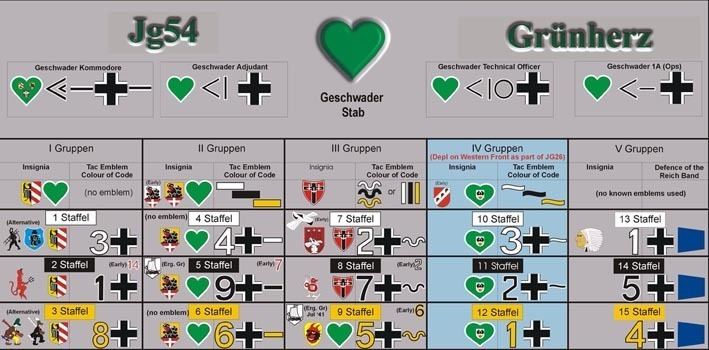 | ||
Similar Jagdgeschwader 2, Jagdgeschwader 26, Jagdgeschwader 3, Jagdgeschwader 27, Jagdgeschwader 300 | ||
Jagdgeschwader 54 (JG 54) was a Luftwaffe fighter wing during the Second World War, which was the second highest scoring wing of all time, JG 52 being the highest. JG 54 flew on the Eastern Front claiming over 9,600 aircraft shot down, with pilots such as Walter Nowotny, Otto Kittel, Hans-Ekkehard Bob, Max-Hellmuth Ostermann and Hannes Trautloft being termed Experten.
Contents
- Formation
- Invasion of Poland
- Invasion of France and the Low Countries
- The Battle of Britain
- The Eastern Front
- The Western Front
- Commanding officers
- References
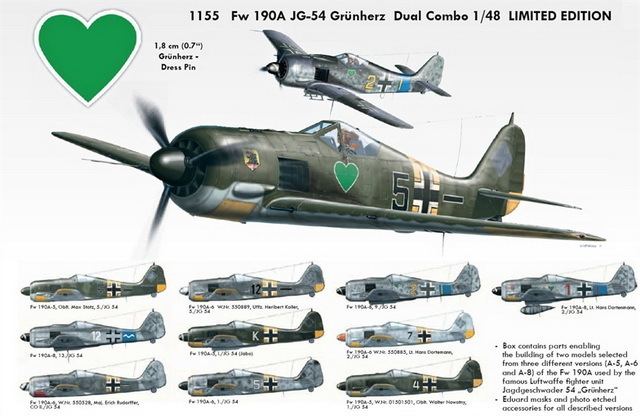
Having participated in the air battles over the Channel and South-east England during the summer of 1940, the unit was transferred to the Eastern Front in the spring of 1941 for Operation Barbarossa, the invasion of the Soviet Union. JG 54 first flew Bf 109Fs and then the Fw 190.
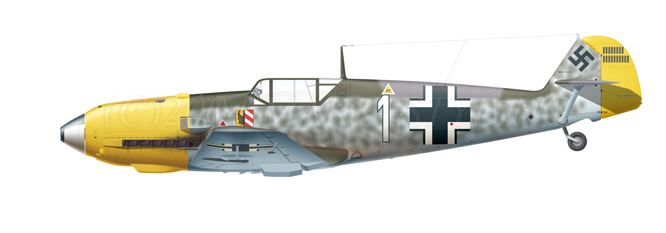
Formation
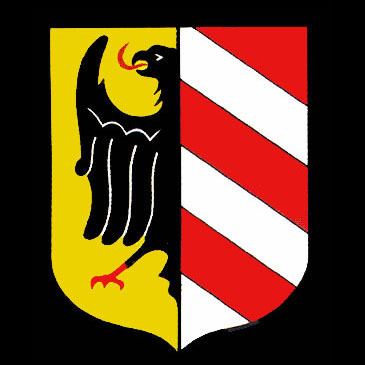
I./JG 54 was initially formed as I./JG 70 in July 1939. On 15 September 1939, I./JG 70 was redesignated I./JG 54. The initial unit designation for II./JG 54 was I./JG 138. This unit was raised in 1938 after the Austrian annexation. Thus many Austrian nationals were recruited when I./JG 138 was formed. I./JG 138 was briefly designated I./JG 76 before finally becoming II./JG 54 on 6 April 1940.
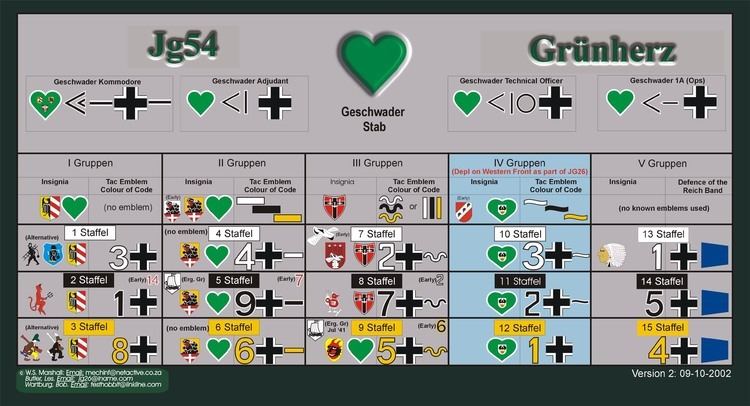
III./JG 54 was initially raised as I./JG 21. On 15 July 1939, I./JG 21 was redesignated III./JG 54. However, the bureaucratic nature of the young Luftwaffe was such that it was over a year before records would reflect the new designation. Thus III./JG 54 fought in Poland and France as I./JG 21.
Invasion of Poland
JG 54 took part the invasion of Poland in September–October 1939. II/JG 54 and III/JG 54 saw combat, while I/JG 54 remained stationed in Herzogenaurach. Equipped with BF 109Ds their operations consisted of ground attack, air superiority and escorting Stukas.
Invasion of France and the Low Countries
JG 54 was transferred back to Germany on 9 October 1939. Before the invasion of France, during a period known as Phoney War, they operated mainly in an air defence role. The Geschwader began to field Bf 109Es at this time as well.
The Battle of France broke out on 10 May 1940. The Luftwaffe operated by advancing in front of the German army to destroy French airfields and bomb cities, industrial complexes and transportation hubs. JG 54's role was to escort the bombers (Stukas and Heinkel He 111s mostly)) and to conduct fighter sweeps in French airspace in order to maintain air superiority. These roles were maintained throughout the operations at Dunkirk against the evacuating British Expeditionary Force. During the period 10 May to 21 June (until their transfer to the Netherlands and the capitulation of France) JG 54 claimed 17 aircraft, according to JG 54 documentation.
Before the Battle of Britain the Geschwader were again transferred to the Netherlands. In a British raid on the Soesterberg airfield, III/JG 54 suffered heavy ground crew and equipment losses. While in the Netherlands they claimed another 21 aircraft (20 Blenheim Bombers and 1 Supermarine Spitfire)
The Battle of Britain
The Battle of Britain began in late July and early August, with the goal of destroying the RAF, a prerequisite of a land invasion of Britain. The three JG 54 Gruppen were transferred to airfields near Calais on 6 August 1940. Dissatisfied with the fighter arm's poor performance in the operation, Göring's subsequent purge lead to the command shake up in mid 1940. Major Hannes Trautloft was placed in command of JG 54 as a result. The Battle of Britain proved costly for both the Luftwaffe and JG 54. The Geschwader lost 43 pilots, 40 percent of its strength at the onset of the operation. JG 54 however claimed some 238 enemy aircraft destroyed.
After the Luftwaffe's defeat, the three gruppen were all assigned to separate locations once again. I/JG 54 was assigned as a subordinate of JG 1 from [27 September], 1940 until May 1941; II/JG 54 was given winter's rest from 3 December 1940, until 23 January 1941 at Delmenhorst airfield; III/JG 54 was put on a similar rest. II/JG54 and III/JG 54 served briefly in France at Le Mans and Cherbourg; due to quiet conditions much of the unit's time was devoted to training. On 29 March 1941 Stab, II, and III/JG 54 were relocated to the Balkans. Conducting mostly ground attack operations on locomotives and rolling stock, they also encountered Yugoslavian BF 109Ds that had been purchased from Germany prior to hostilities. After the defeat of Yugoslavia, the unit was transferred into Prussia in preparation for Operation Barbarossa.
The Eastern Front
Claiming 45 planes destroyed on the first day, JG 54 was assigned to Army Group North during the Operation Barbarossa, the invasion of Soviet Union on 22 June 1941 as part of the Luftwaffe's Luftflotte 1. It remained on that part of the Eastern Front for most of its existence. JG 54's operations for 1941-43 had a twofold objective: to keep pressure upon the Leningrad sector, and to reduce Soviet pressure on the Lake Ilmen area at the German flank.
By 18 July the Geschwader had recorded its 500th Soviet air claim, and on 1 August became the third Geschwader to claim 1,000 aircraft destroyed. In the period 22 June - 5 December 1941 the unit destroyed 1,078 Soviet aircraft in return for 46 losses in aerial combat and a single fighter on the ground. Trautloft instituted the successful tactic of intercepting Soviet nuisance raiders on moonlit nights, and JG 54 claimed 56 kills in January–July 1942 while suffering no losses on these interceptions. In February 1942 alone JG 54 claimed 201 air victories for 18 pilots killed in action.
JG 54 received its first Focke Wulf Fw 190's in February 1943, and on 23 February 1943, JG 54 claimed its 4,000 kill. On 7 March 1943 the unit claimed 59 aircraft shot down in one day. Trautloft left JG 54 in July 1943 when General der Jagdflieger Adolf Galland asked him to join his staff as Inspizient Ost. (He ended the war with 57 victories and the Knight's Cross of the Iron Cross.) After his departure JG 54 continued operating on the Northern Front, and their victory tally rose continuously. Feldwebel Helmut Missner was credited with JG 54's aerial victory on 17 July 1943. The 7,000 JG 54 claim was made on 23 March 1944, with the 8,000 mark passed on 15 August.
I.,II. and IV./ JG 54 ended the war fighting around the Baltic region, supporting the troops of Army Group North through Latvia and Estonia, and into the Courland Pocket of East Prussia. JG 54 could never hope to regain air superiority against the mounting number of Russian aircraft. The Russians never defeated Army Group North, which held out until the last day of the war, surrendering 210,000 Germans to the Soviets in Courland.
The remaining serviceable FW-190's were ordered fly to Flensburg on the Danish border, with the German Navy evacuating as many of the ground personnel as possible by ship. The JG 54 pilots, led by Oberst Dietrich Hrabak, ripped out all unnecessary equipment from the fighters, allowing room to take two men, one man crouching behind the seat and the other fitting into the fuselage. In this way at least 90 JG 54 personnel escaped Russian capture.
The Western Front
In February 1943 III./JG 54 was transferred back to the west for operations against the RAF and USAAF. At first they operated as stand-alone BF 109 unit, but later were attached to JG 26. Intensive training in the more rigorous techniques of fighting on the Western Front were only partly successful, and Oberst Josef Priller, Geschwaderkommodore of JG 26 and charged with III gruppe's training, refused to declare the gruppe operational. III Gruppe transferred to North Germany as a result, supporting Jagdgeschwader 1.
In the autumn of 1944, the III./JG 54 became the inaugural Luftwaffe squadron to receive the newly developed Fw 190 D-9 "Dora" aircraft. These aircraft were initially deployed in defense of the Me 262 jet bases of Kommando Nowotny, and subsequently in operations over North-West Europe. By early December, 68 of these aircraft were operational. However, significant losses soon led to the disbandment of the group. On December 29, 1944, 'Bazi' Weiß, the Gruppenkommandeur, along with twelve other pilots, was killed in combat with RAF fighters.
At the end of 1944 ZG 76 was disbanded and its pilots formed the nucleus of a new III./JG 54. Operating from Berlin, the unit's Fw 190s saw intensive action against Soviet ground targets such as road and rail supply columns, flak positions, armour and the bridges across the River Oder. A few weeks before the war ended, the depleted III./JG 54 was disbanded, being absorbed into JG 26.
Although Luftwaffe documentation were destroyed at the end of the war surviving records indicate JG 54 lost 491 pilots killed in action and 242 pilots missing. A further 322 pilots were wounded in action. The ground personnel lost 570 killed. Total losses in aircraft were approximately 1071 Bf 109 and 746 FW 190.
